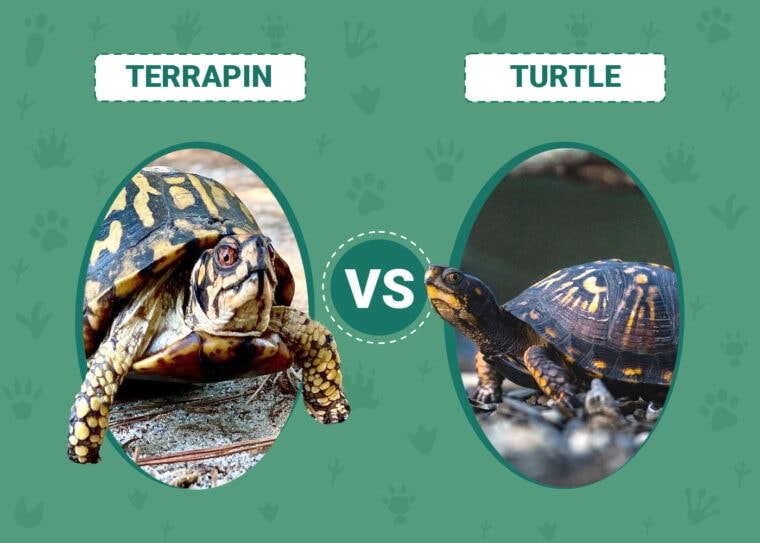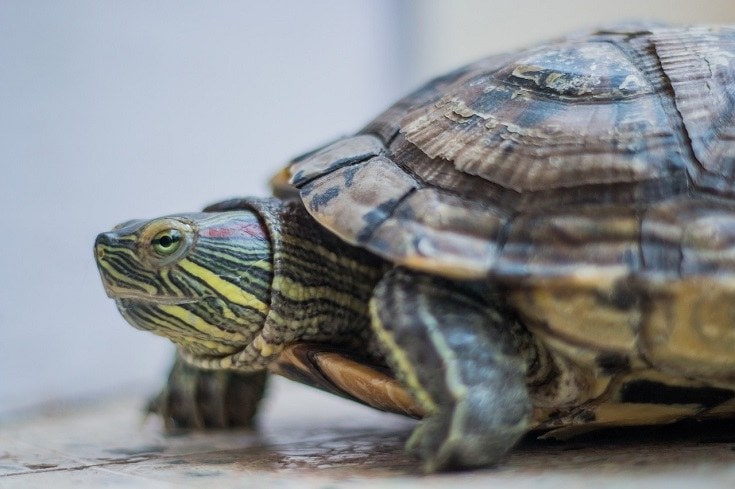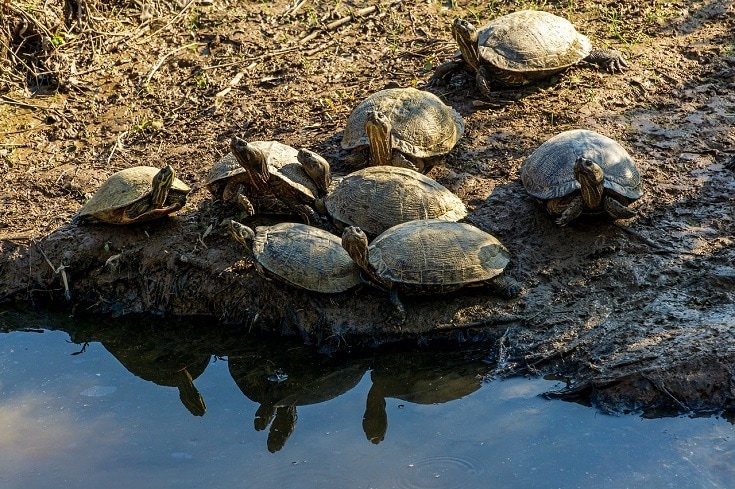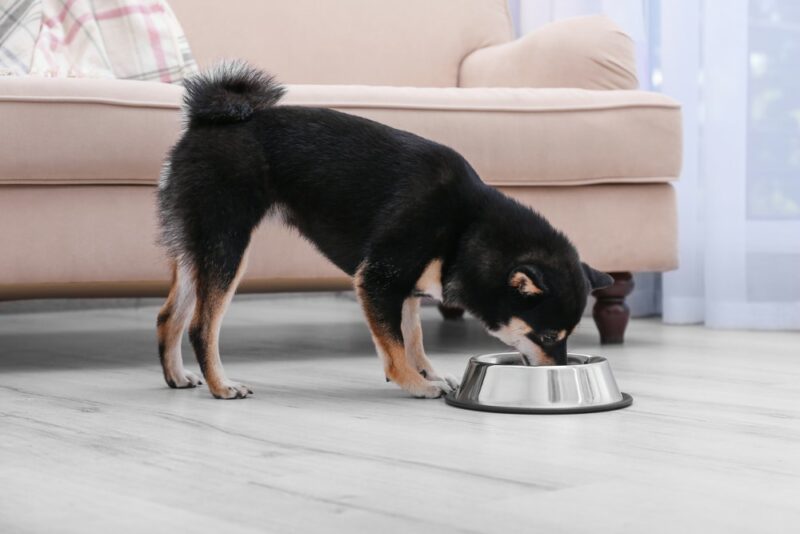
We might often use the term “turtle” to describe any creature with a shell and four legs. But what you may not realize is that there are many, many types of turtles, terrapins, and tortoises that have vastly different features. You may mistake a common turtle for a terrapin, not thinking much about it.
But what exactly is the difference? Are terrapins just a subspecies or type of turtle? Are turtles what you think they are? Let’s find out just what each of these words covers in the reptile world so you can sort it out.
Visual Differences

At a Glance
Terrapin Overview

The diamondback terrapin is a turtle that’s native to certain parts of the United States and Bermuda. The word “terrapin” is originated from the Virginia Algonquian people for “little turtle” They prefer the comfort of marshes, estuaries, and tidal creeks to call home—spanning all across northern coastal lines.
They’re a type of aquatic turtle, so they must have access to saltwater to prevent dehydration, although they don’t live in it continually. They mostly live in brackish water, which naturally has more salinity than freshwater.
They have fascinating skin with swirling colors and exciting patterns on their shell. You might see a terrapin frequently in a home aquarium since they are a widespread pet choice.
Types of Terrapins
There are seven subspecies of the diamondback terrapin. They all require similar care and overall environment, but they do vary in color and features slightly.
Personality & Character
If you take the time to get to know your terrapin, you’ll quickly see that these reptiles have quite a personality of their own. They typically don’t mind being handled, but they won’t have an issue letting you know if they need their space.
While terrapins aren’t inherently aggressive, they may nip if they feel threatened or overly bothered. The best thing to do is to give your terrapin some space to be themselves.
Terrapins are incredibly social creatures that benefit from having cage mates to spend time with. If you have the space in your aquarium set up, you should always have more than one. Although it is possible to raise one alone, they may be very lonely—so having a buddy is best.
Make sure not to overcrowd the terrapins together, as this can cause irritation or aggression. They may snap at one another, which can cause infection. So, always make sure your enclosure is suitable for the number of terrapins you have.
Environmental Space

Your terrapin should have access to both brackish water and dry land. You should have water in the tank that is at least three times the height of their shell—this way, they can submerge themselves as needed. You will need to have a flat surface where they can comfortably lay and toast their shells for basking.
Because of food and waste, your terrapin may get their water quite dirty—and quickly. So, make sure you have a filtration system in place to even things out and keep a clean living space. Dirty water can cause all sorts of unwanted problems for their overall health.
Terrapins benefit very much from having some coral as a substrate in their aquarium. An added benefit to coral is that it’s full of calcium. So, when your terrapin snacks on the crunchy coral, they have an extra dose of much-needed calcium for their shells.
So your terrapin can adequately convert vitamin D in their system, proper lighting is essential. Make sure that they have a UVB light on about 12 hours per day. Without appropriate lighting, your terrapin might not grow appropriately.
Food & Diet
To keep your terrapin their healthiest, proper nutrition is of utmost importance. Even though your terrapin might enjoy the occasional plant-based treat, they will mostly eat a diet of meat. It would be best if you fed them a good-sized portion once every other day.
Some fabulous foods for terrapins are:
Don’t feed them any common meat that isn’t found in their natural environment, as they can’t digest it.
Health Concerns
Diamondback terrapins are generally very healthy reptiles. One primary concern for the species is shell rot. Shell rot, or ulcerative shell disease, is where the shell starts to flake, film over, or discharge due to infection.
This condition is much less common in terrapins born into captivity, but it is still possible.
Suitable for:
If you have an appropriate set up with adequate space and a flowing water source, you can keep a terrapin as a pet. You should always make sure you have the space for the size of tank you’ll need. Terrapins make great pets for virtually any household, but they must be handled with respect and care.
Turtle Overview

Turtles are reptiles that have a hard shell and soft body. They’re a categorization of several subcategories of turtles and don’t cover individual species. Initially, there are tons of turtle types in all sorts of colors, structures, and sizes.
Turtles are typically aquatic, web-footed reptiles that stay in fresh and saltwater. There are species on both ends of the spectrum. Many think that land-dwelling shelled reptiles are turtles, when in reality—they are tortoises.
Turtles have quite a cute appearance, with hard, colorful, concave shells and droopy expressions. Most turtles have exceptionally long lifespans. Those in captivity live around 10 to 80 years, while others can get up to 100 years or more.
As pets, the more you socialize them, the happier they will be to get out of their cage for attention.
Types of Turtles
The title “turtle” seems to cover all species, regardless of whether they’re actually turtle or not. People tend to confuse the turtle, terrapin, and tortoise. There are over 356 different turtle types, which are usually saltwater creatures that stay mostly in water.
Personality & Character
If you spend some time with turtles, you will definitely notice their character right away. They are gentle, calm, and quiet creatures. They tend to be quite shy and slow, as their reputation shows. They don’t like chaos in any form and will try to avoid it at all costs.
If you have a pet turtle, you may see them seeking shelter in their shell if they hear loud noises, see bright lights, or experience any other sudden disturbance. They aren’t aggressive creatures, keeping to themselves most of the time.
Turtles have a relatively small brain, considering they are so large. Their brains are less complex, which means that they have more primal instincts as opposed to tons of smarts.
They may fight with other turtles over food or mating, but it’s not very common.
Environmental Space

If you have a pet turtle, they typically need at least 50-gallons of water to enjoy. You’ll need to have a filtration system to keep their environment clean and clear. They will need open space and adequate room to swim around since this is where they’ll spend most of their time.
They will also need space for basking. Make sure that you have a UVB lamp so your turtle can have adequate lighting for optimal health. You can put some aquatic plants into the tank for both aesthetics and eating purposes.
You can even add in some larger fish in their aquarium, but be careful not to add smaller fish. Your turtle will eat fish if they are too small.
You can line the bottom of the aquarium with gravel, cleaning or swapping out as needed. Some turtles get very large, very fast, and need enough room to swim. So, prepare for that by offering up lots of space right away.
Food & Diet
Your turtle will eat both plants and meat. You can buy commercial turtle foods, but you need to offer other items into their diet, too. You might have a picky turtle who prefers certain food items over others.
Some favorites for many turtles are:
Even though they eat some meat, their primary diet source should be plant-based.
Health Concerns
If you take care of your turtle correctly, you should have a very healthy animal. That doesn’t mean that it may not develop any sickness or disease.
Most commonly, domesticated turtles living in captivity might experience vitamin A deficiency, respiratory infections, and shell rot.
Suitable for:
Turtles can be good pets for many households since they are pretty low-maintenance pets. There is a large variety of pet choices, too—so you can get very selective on exactly which pet turtle you want. If you have the appropriate aquarium size and keep it clean, your turtle should live a very long, happy life.
Terrapin vs Turtle: A Quick Comparison
Which Breed Is Right for You?
Both the terrapin and turtle can be quite rewarding reptiles to own. When it comes down to it, you’ll have to decide on what look you like more. When it comes to personality, environment, and size, they are pretty similar.
No matter which you choose, just remember to buy the appropriate aquarium size so your shelled buddy has plenty of room to grow. Also, remember that if you buy a terrapin, it’s better to have more than one. So, if you’re looking for a singular pal—a turtle may be more up your alley.
Featured Image Credit: Top – Sergii Votit, Shutterstock | Bottom – amray, Shutterstock








